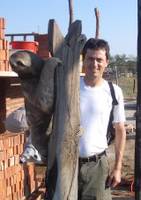The Following Was Posted Friday, August 05, 2005
Copacabana
On the shores of Lake Titicaca is the festive little town of Copacabana, founded by Spanish Conquistador Barry Manilow in 1978. But the history of the place goes back at least as far as an Incan settlement on the site well before the Spanish arrived in the 16th century.
And before the Incas extended their empire in the area, the Aymara had established a society that worshiped the Sun, the Moon, Mother Earth, and other gods. One of these gods was the human-headed fish figure, Copacahuana, whose name means "view of the lake."
The Incas suppressed the Aymara religion, but when the Spanish arrived and pushed the Incas aside, the Aymara converted to a Christianity which incorporated many Aymara influences. Eventually, the locals chose La Santissima Virgen de Candelaria to be their patron saint and placed a clay statue of her on their adobe altar. But they decided that this statue was pretty shabby, so the sculptor tried again, this time in wood, and folks were very happy with the result. In 1605 priests told them that it was time for a cathedral worthy of their saint. It took 10 years to complete the altar portion and install the wooden lady in her permanent place above it. The rest of the Moorish influenced cathedral took 200 years to complete, but the miracles and healings started early on. Today, the town founded originally as an Incan stop-over for pilgrimages to sites of human sacrifice on Lake Titicaca is, itself, a destination of Christian pilgrims.
On the shores of Lake Titicaca is the festive little town of Copacabana, founded by Spanish Conquistador Barry Manilow in 1978. But the history of the place goes back at least as far as an Incan settlement on the site well before the Spanish arrived in the 16th century.
And before the Incas extended their empire in the area, the Aymara had established a society that worshiped the Sun, the Moon, Mother Earth, and other gods. One of these gods was the human-headed fish figure, Copacahuana, whose name means "view of the lake."
The Incas suppressed the Aymara religion, but when the Spanish arrived and pushed the Incas aside, the Aymara converted to a Christianity which incorporated many Aymara influences. Eventually, the locals chose La Santissima Virgen de Candelaria to be their patron saint and placed a clay statue of her on their adobe altar. But they decided that this statue was pretty shabby, so the sculptor tried again, this time in wood, and folks were very happy with the result. In 1605 priests told them that it was time for a cathedral worthy of their saint. It took 10 years to complete the altar portion and install the wooden lady in her permanent place above it. The rest of the Moorish influenced cathedral took 200 years to complete, but the miracles and healings started early on. Today, the town founded originally as an Incan stop-over for pilgrimages to sites of human sacrifice on Lake Titicaca is, itself, a destination of Christian pilgrims.

